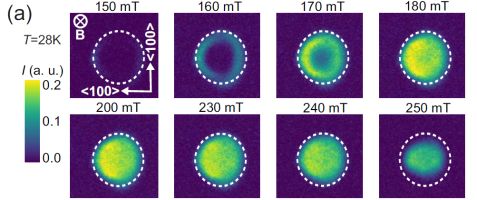MLZ is a cooperation between:
 > Technische Universität München
> Technische Universität München > Helmholtz-Zentrum Hereon
> Helmholtz-Zentrum Hereon
 > Forschungszentrum Jülich
> Forschungszentrum Jülich
MLZ is a member of:
 > LENS
> LENS > ERF-AISBL
> ERF-AISBL
MLZ on social media:

MLZ (eng)
Lichtenbergstr.1
85748 Garching
05.02.2018
Disenchanted Exotic: Neutrons show how skyrmions form
Magnetic skyrmions can potentially store information in a higher density than today’s data carriers. Since their discovery using neutrons at the FRM II in 2009, research on magnetic skyrmions is booming. For the first time, physicists of the Technical University of Munich have used a specially adapted imaging technique at the MLZ in order to clarify exactly how and where the magnetic vortex structure of the skyrmion lattice forms in extended bulk samples.
While magnetic skyrmions are identified in an increasing number of materials and meanwhile even at room temperature, scientists are still debating how exactly the skyrmion lattice forms and how it disappears. Due to its special vortex structure the skyrmion lattice gets intriguing stability, so the skyrmions cannot decay easily – this is exactly what makes skyrmions so interesting for data storage.
The decay of skyrmions has been investigated in recent years at FRM II using neutrons. Below the magnetic transition temperature the skyrmion phase is surrounded by the conical phase. However, measurements of specific heat and magnetization show that the expected first order phase transition is indeed a broad crossover region. “In the past, this crossover region has been intensely debated, often involving exotic physics“ says Dr. Sebastian Mühlbauer of the MLZ. In order to investigate the formation of skyrmions in more detail, the scientists have examined this transition region in the compound MnSi at the ANTARES radiography facility with Dr. Michael Schulz using a special experimental setup.

Radiographies showing how the skyrmion phase is forming depending on increasing magnetic field. It is only at intermediate fields where the sample is entirely filled with the skyrmion lattice phase. © FRM II / TUM
Tommy Reimann installed a microscopically perforated absorbing plate (micro-channel plate) into the neutron beam behind the manganese silicide sample. This perforated plate acts like a high-resolution collimator, which allows separating the neutrons scattered from the skyrmion lattice from the measurement background. The small distance of the ANTARES detector to the sample allows to spatially resolve the positions where the neutrons were scattered in the sample. Accordingly, it became immediately clear which part of the sample is currently in the skyrmion lattice phase. In contrast to microscopic measurements, which usually only have a field-of-view of a few tens of micrometers, this method allows for the first time a spatially resolved examination of bulk macroscopic samples.
Sebastian Mühlbauer explains: “We could show exactly that macroscopic phase coexistence takes place in the crossover region between the two phases. Not more and not less. The skyrmion phase forms at the edges of the sample and slowly creeps inside the sample. This is simply caused by the fact that the magnetic field applied to the sample is being distorted by the magnetization of the sample itself. Consequently it is not uniformly distributed everywhere.” The scientists have thus disenchanted the exotic physics in the crossover phase.
Original publication:
Neutron diffractive imaging of the skyrmion lattice nucleation in MnSi
T. Reimann, A. Bauer, C. Pfleiderer, P. Böni, P. Trtik, A. Tremsin, M. Schulz, and S. Mühlbauer Phys. Rev. B 97, 020406®
Published 12 January 2018
DOI: https://doi.org/10.1103/PhysRevB.97.020406
Related News
-
30.05.2013
Magnetic monopoles erase data
MLZ is a cooperation between:
 > Technische Universität München
> Technische Universität München > Helmholtz-Zentrum Hereon
> Helmholtz-Zentrum Hereon
 > Forschungszentrum Jülich
> Forschungszentrum Jülich
MLZ is a member of:
 > LENS
> LENS > ERF-AISBL
> ERF-AISBL
MLZ on social media:






